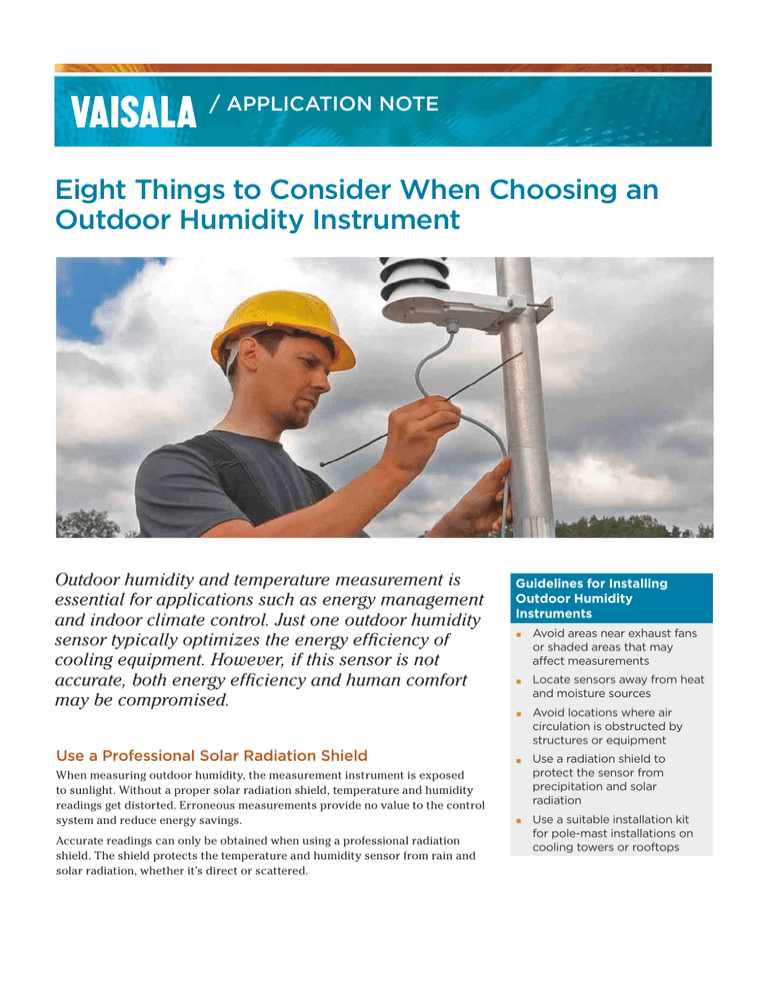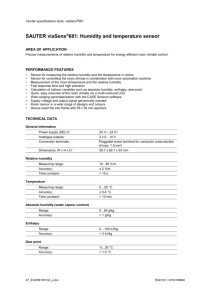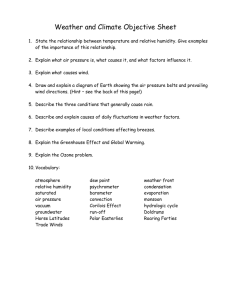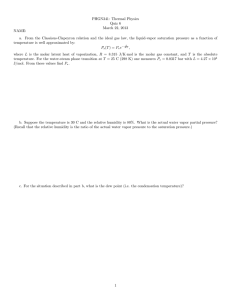
/ APPLICATION NOTE
Eight Things to Consider When Choosing an
Outdoor Humidity Instrument
Outdoor humidity and temperature measurement is
essential for applications such as energy management
and indoor climate control. Just one outdoor humidity
sensor typically optimizes the energy efficiency of
cooling equipment. However, if this sensor is not
accurate, both energy efficiency and human comfort
may be compromised.
Guidelines for Installing
Outdoor Humidity
Instruments
Use a Professional Solar Radiation Shield
When measuring outdoor humidity, the measurement instrument is exposed
to sunlight. Without a proper solar radiation shield, temperature and humidity
readings get distorted. Erroneous measurements provide no value to the control
system and reduce energy savings.
Accurate readings can only be obtained when using a professional radiation
shield. The shield protects the temperature and humidity sensor from rain and
solar radiation, whether it’s direct or scattered.
▪
Avoid areas near exhaust fans
or shaded areas that may
affect measurements
▪
Locate sensors away from heat
and moisture sources
▪
Avoid locations where air
circulation is obstructed by
structures or equipment
▪
Use a radiation shield to
protect the sensor from
precipitation and solar
radiation
▪
Use a suitable installation kit
for pole-mast installations on
cooling towers or rooftops
Eight Things to Remember
When Choosing an Outdoor Humidity
Instrument
Temperature Dependency
– the Challenge of Outdoor Humidity
Measurement
1. Ensure that the instrument works even in your most
demanding conditions. The operating temperature
range should be from -40 to 60°C (-40 to 140°F) and the
instrument should measure the full 0 to 100% RH range.
Relative humidity (RH) measurement is a temperaturedependent parameter. RH can be defined as the ratio of
the partial water vapor pressure (Pw) to the water vapor
saturation pressure (Pws) at a particular temperature:
2. Never purchase a humidity sensor for outdoor
measurements without a proper radiation shield.
%RH = 100% × Pw / Pws
3. The radiation shield should be designed for use with
your specific humidity sensor to ensure optimal
performance.
4. The radiation shield can be made of either metal or
plastic, but it should have low thermal conductivity,
high reflectivity, good corrosion resistance, UV
durability, and resistance to dirt accumulation.
5. The enclosure should protect both the electronics and
the humidity sensor from rainwater, dust, and dirt.
As the denominator in the definition (Pws) is a function
of temperature, relative humidity is strongly temperature
dependent.
For example, at 20°C and with a relative humidity of 50%,
increasing the temperature to 25°C will decrease RH to
about 37%, even though the partial pressure of the water
vapor remains the same. This shows how important
it is to understand the conditions in the measurement
environment when striving for accurate and reliable
humidity measurements.
6. Consider installation accessories and ease of
installation for your selected installation site: pole,
horizontal beam, flat surface, or wall.
7. Ensure the sensor can recover rapidly from
condensation for undisturbed operation outdoors.
8. Make sure that the humidity sensor can be easily
calibrated according to your needs – either on-site
without detaching the instrument or off-site at a
calibration facility.
The Elements of a Good Radiation Shield
Radiation Shield Material:
• Non water-absorbing
• Dirt and corrosion resistant
• Low thermal conductivity
• UV proof
Functional Design
• White external surface that efficiently reflects solar radiation
• Black inside to absorb accumulated heat and scattered solar radiation
• Efficient air flow to sensor due to its uniquely profiled and naturally
ventilated multiple disc structure
• No moving parts – requires no maintenance
The Most Common Humidity Parameters Used in Free Cooling
Parameter
Description
Dew point
When a gas is cooled and gaseous water vapor begins to condense in the liquid phase, the temperature
has reached the dew point temperature (Td). Thus at 100 %RH the ambient temperature equals the
dew point temperature. The more negative the dew point is from the ambient temperature, the smaller
the risk for condensation and therefore the drier the air. Unlike relative humidity, dew point is not
temperature dependent but it is affected by pressure.
Wet bulb
temperature
Traditionally, the wet bulb temperature (Tw) is the temperature indicated by a thermometer wrapped in
a wet cotton sheath. In air conditioning applications, the wet bulb temperature is compared to the dry
bulb temperature to determine the cooling capacity of evaporative coolers.
Enthalpy
Enthalpy is defined as the amount of energy required to bring a gas to its current state from a dry gas at
0°C. The specific enthalpy of moist air is defined as the total enthalpy of dry air (sensible heat) mixed
with the water vapor (latent heat) per unit mass of moist air. The value is calculated as the difference to
the selected reference state. For metric units (kJ/kg), the reference state is dry air at 0°C. For non-metric
units (Btu/lb), the reference state is dry air at 0°F. Enthalpy is used in air conditioning calculations.
Vaisala Outdoor Humidity Instruments
Vaisala has over 75 years of experience in professional
weather measurement, and our outdoor instruments have
been tested in the most demanding conditions to ensure
reliable operation. Explore our full portfolio of HVAC
outdoor instruments at www.vaisala.com/HVAC.
We are happy to help you with any questions you might
have about measuring outdoor humidity and temperature.
Find your local contact at www.vaisala.com/contact.
You can also watch the installation video of Vaisala's Outdoor Humidity and
Temperature Transmitter HMS80 to learn how easy it is:
www.vaisala.com/HMS80
Please contact us at
www.vaisala.com/requestinfo
www.vaisala.com
Ref. B211371EN-A ©Vaisala 2014
Scan the code for
more information
This material is subject to copyright protection, with all
copyrights retained by Vaisala and its individual partners. All
rights reserved. Any logos and/or product names are trademarks
of Vaisala or its individual partners. The reproduction, transfer,
distribution or storage of information contained in this brochure
in any form without the prior written consent of Vaisala is strictly
prohibited. All specifications — technical included — are subject
to change without notice.




